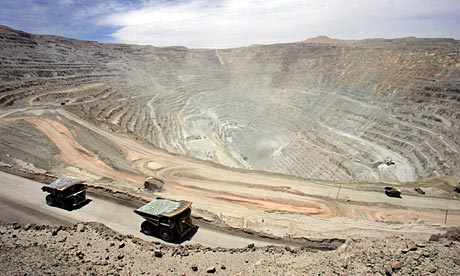It was God luck that initially saved those 33 miners when the mountain collapsed, but it was not  luck that kept them alive
luck that kept them alive
Mining created Chile. The story of men who go down into the mountain and chip away at minerals in the darkness and then suffer an accident that leaves them at the mercy of that darkness is part of the DNA of Chile, an integral part of the country's history. It was one of the first things I learned about Chile when I arrived there in 1954 at the age of 12.
"Open your books to the story El Chiflón del Diablo," our Spanish teacher said on the first day of class. "The Devil's Tunnel by Baldomero Lillo. Written in 1904."
It was a story very much like the one that, many decades later on 6 August 2010, would afflict the miners of San José. It is all there – how the earth devours those who dare to probe its depths, in that classic story and all the others that Lillo wrote at the beginning of the 20th century and that every child in Chile studies. Those 33 miners could not know when they read those stories in school that they would someday be living that terror. They could not know that more than 100 years after that fiction was written that the conditions of mining life, the risks to the miners and the inhumane exploitation would be basically unaltered.
People around the world have been amazed at how the 33 miners have organised themselves in shifts, generated a hierarchy of command and crafted a plan for survival drawing from all the skills they have accumulated through their working lives. I am not in the least surprised. This has always been how Chilean workers have endured and persisted in the face of tremendous challenges. It is the legacy of those who extracted nitrate and who, at about the time that Lillo was writing about the torments of miners, were establishing the first trade unions, reading groups and newspapers of the Chilean working class. Those lessons of unity, fortitude and orderliness were handed down from father to son to grandson. It was what each male needed to know in order to outlive the disasters that could befall him in a merciless environment.
Of course, it was luck that initially saved those 33 miners when the mountain collapsed. But it was not luck that kept them alive. Inside them was the training and stamina inherited from forefathers, murmurs from those who were not willing to die over and over again in the darkness. There was a miracle at work, therefore, in San José, but to focus exclusively on good fortune is to perhaps miss the true and deeper significance of what happened. It begs the real question..
How is it possible that, more than a century after Lillo's stories denounced the inhuman conditions of men toiling underground, that insecurity and danger persist? How many more accidents like this one will be needed before legislation to mandate safeguards is enacted and workers can descend into the mountain without putting their lives needlessly at risk?
These 33 miners are now international heroes, with the world celebrating their rescue and their progress towards the light.
By one of those coincidences that history loves, these men were buried at the moment when the latest statistics show that the percentage of Chileans living in poverty has, for the first time since the end of Augusto Pinochet's dictatorship, gone drastically up rather than down.
Is it too much to hope that the ordeal these men have gone through will trouble the conscience of Chile and create a country where, 100 years from now, the stories of Baldomero Lillo and the story of the 33 miners from San José, will be a thing of the past? Now that would be a real miracle.